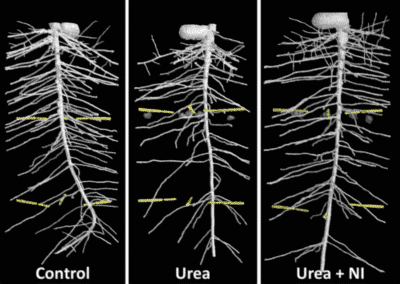
Dynamics of Nitrogen Species in Soil and their Relevance for Root System Morphology – What Have We Learned from Drew?
Only 30-50% of applied N fertilizers are captured by crops. Therefore increasing both, N use efficiency and crop production is a major challenge for sustainable agriculture. Urea is the most widely used N fertilizer. Urea undergoes rapid hydrolisation applied at the soil, after which ammonium is oxidized to nitrate. Due to the use of nitrification inhibitors, the importance of NH4+ as N source has increased. NH4+ is more protected against nitrification creating benefits for environment and plant growth.
Application of urea granules with or without inhibitors is expected to result in a spatially heterogeneous and temporally dynamic distribution of different N-forms in the soil matrix. Plasticity of root growth can be observed when roots are exposed to localized sources of nitrogen. Two general ways of response seem to be common including systemic repression of lateral root growth by high N status of the plant and local stimulation by initiation and elongation or inhibition of lateral root growth by availability of NO3 or NH4. These effects are related to the nutritional and signalling effect of the respective ion but dynamics are difficult to observe due to the opaque nature of soil.
The aim of this work is to verify hypotheses, derived from studies with flow-through-systems or gel plates, for soil systems, using X-ray micro tomography to visualize and characterize dynamic root system development in soil as a response to different N-forms in situ for Vicia faba (Fig1) and via several harvests over time for Hordeum vulgare and Zea mays. These analyses are combined with soil chemical studies.

This setup is applied to answer the questions when, where and why do modifications of root system architecture occur in relation to soil chemical and N-nutritional conditions with similarities but also contrasting results for the three plant species, e.g. regarding total root length (Fig2):

Powered by Eventact EMS